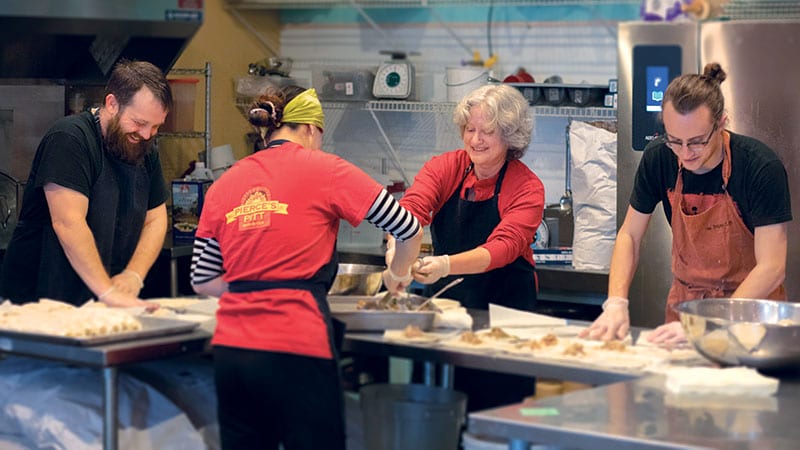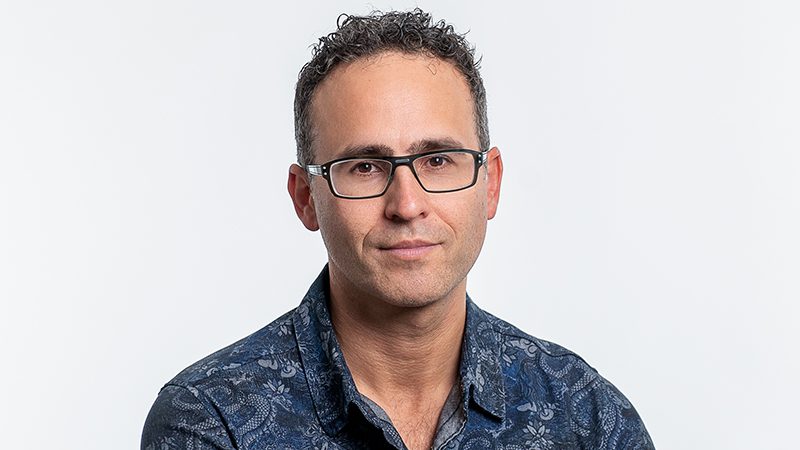What’s different about shopping at a food co-op?
This article was originally published in April 2024

What does a co-op look like?
Seattle has some remarkable answers to that question, from PCC Community Markets and other food co-ops to REI to credit union BECU (a PCC partner) to Patty Pan, a worker-owned co-operative whose tamales are stocked at PCC stores.
PCC is marking 2024 as The Year of the Co-op through education on co-op principles and celebrating our members and how their support supports the community.
This month, Sound Consumer presents a Q&A with Jon Steinman, author of “Grocery Story: The Promise of Food Co-ops in an Age of Grocery Giants” and founder of the Food Co-op Finder app locating food co-ops around the country. Look for more co-op features in the months to come.
Why do food co-ops matter?
Before considering why food co-ops matter, it’s valuable to first consider why grocery stores matter.
I’ve invested almost 20 years into the investigation and exploration of global and local food systems and have come to a definitive conclusion — grocery stores are the most influential organizations shaping the future of food. If we imagine the food supply chain as a river, there are multiple points along that river where the river narrows. Each of those points is where no more than a handful of companies determine the flow of goods. These narrows include the agricultural commodity traders, food processors, food manufacturers, and finally, the grocery retailers. But the grocers exercise a unique form of control. They determine which foods are available to us as the end consumer. In that way, they determine everything that happens upstream — the shaping of the entire food system. Grocery stores are gatekeepers — deciding which foods make it to market, and which don’t. What I love about the cooperative model, is it places consumers into that all-important and mightily powerful gatekeeper role. By enabling consumers to literally own their grocery store alongside thousands of their neighbors, consumers are no longer at the mercy of private interests deciding the future of food. We do.
I must also mention the power of the cooperative model. We are at a pivotal moment where concentration of ownership of the businesses and services that we most depend upon is at an all-time high. Social media is a cautionary example of what an unregulated and unrestrained industry of importance can become in short course, whereby a few private interests are left to command what have become essential platforms for many people and businesses. Grocery stores are also essential. They are the primary point of access to nourishment and health. As food system gatekeepers, they also shape the planet and our climate. While we can certainly advocate for government to hold grocery retailers accountable for their scope of influence, the cooperative model allows for people to take on that role immediately. Co-ops democratize the economy.
What’s different about shopping at a food co-op vs. another kind of grocery store?
I’ll share my personal experience of spending money at a co-op. For every dollar I spend, whether it’s what I spend at the checkout of my food co-op, or the fees I incur through my credit union (also a co-op!), or the hiking shoes I purchase at REI, my experience is much less one of ‘expense’ and far more one of ‘investment’. After all, co-ops can’t profit off of their members. Many co-ops may very well be for-profit organizations, but 100% of those profits are returned back into the business or through a patronage dividend in the form of cash or store credit. One way I look at it, is that once a year, so long as my food co-op is profitable, my grocery store is effectively apologizing to me for charging me too much. In turn, my grocery store returns some of that excess. This has dramatically transformed my relationship to that moment of financial exchange. Regardless of how much I spend, I instead trust that all of it will come to benefit me, my family, and my community. No one outside of my community will extract that excess. It’s not an experience I have at most other businesses and certainly not at any other grocery store.
How does PCC fit into this?
There’s clearly a strong interest in Seattle to upend the status quo through more conscientious sourcing of food. Privately-owned interests have wasted no time to serve that demand by expanding rapidly throughout the metropolitan region. How then might a Seattle neighborhood meet its own demands through the cooperative model like the successes in Dayton, Boston and Detroit (see below)? In a fast-changing city like Seattle, this is considerably more complicated. Between 2007-2017, it was reported that King County added nearly 50 grocery stores, 9 of which offered predominantly natural foods. The period to develop a new food co-op from the ground up on the other hand, takes a slow 5-10 years. This presents a pretty risky business proposition when the demographics and competitive landscape of a Seattle neighborhood can change dramatically in that same time. This is where PCC fits in. With 15 locations, your co-op is by far the largest in the country, making it unique among food co-ops nationwide. PCC uses its scale to build stores more quickly than any newly-formed co-op could manage on its own. Your co-op’s expansion strategy has become an engine for the cooperative model to be more rapidly integrated throughout the city — affording as many residents as possible a choice between a privately-owned store, for which they have no influence over its future, or a democratically-governed store that they themselves own… that YOU own!
Can you tell us just a little about the history of co-ops in the U.S., and where we are now?
Co-ops of all types have historically formed during periods where dominant systems either fail, or when it’s recognized by enough people that those systems aren’t serving their needs. Rather than rely on government or the private sector, the people most affected come together to steward these needs. This is the origin of the Black-led agricultural co-ops of the late 19th and early 20th centuries, the Antigonish Movement of credit union formation in early 20th century Canada, and the food co-ops of the Great Depression and the 1960s/1970s. What ties the historic waves of co-op development together, is they’re often a response to periods of collapse, discomfort, or deep concern for the future.
What then of today’s development of co-ops? Community-owned grocery stores have certainly been seeing a surge of interest and development over the previous 18 years — 175 new food co-ops to be exact. Much of this interest has emerged out of a concern for the future, particularly, a recognized need to develop grocery stores that prioritize human and environmental health over profit. Another interest in the cooperative model has also arisen out of discomfort, where urban and rural communities have lost access to full-service grocery stores within a reasonable distance from their homes. A particular wave of this interest is in predominantly Black communities, where historic racist policies like redlining had discouraged investment. The effects of these policies continue today. These conditions are what recently inspired the successful development of Gem City Market in Dayton, Ohio (2021), the Dorchester Food Co-op in Boston (2023), and the Detroit People’s Food Co-op, scheduled to open May 2024. All of them are in predominantly Black, underserved communities.
What are some of your takeaways from your research on grocery co-ops? Anything many co-op members would be surprised to learn?
The U.S. food co-op community is unlike any anywhere on earth. This often surprises people both in the U.S. and here in Canada where I live. Food co-ops can certainly be found in many countries, but the scale, diversity, and influence of the American food co-op movement is distinctly different. I’ve visited over 150 of the 320 food co-op locations across the U.S., and each of them is a unique expression of their community’s needs. Same goes for the newest co-ops that have formed in the previous 18 years. Nowhere else on earth have so many community-owned grocery stores been developed in this period. As a point of contrast, with the exception of a handful of inspiring attempts that sadly failed, new food co-op development here in Canada has been but a comparative trickle. Canada certainly does have a substantial network of independent food co-ops from coast to coast to coast, but unlike the U.S. food co-ops, their presence hasn’t compelled much new development to help stem the tide of increasing market concentration among Canada’s privately-owned chains.
I’ve come to believe that the key characteristic of the American food co-ops that compels this growth, is embedded within their missions to change the food system. New food co-op development today — including development among existing food co-ops — is informed, inspired, and supported by these change-making missions. It’s what continues to motivate growth and evolution.
Next time you walk into your PCC, don’t forget that you’re walking into a revolutionary institution that’s changing the world.

Jon Steinman is the author of Grocery Story: the Promise of Food Co-ops in the Age of Grocery Giants (New Society Publishers). He was an elected director from 2006-2016 of the Kootenay Co-op — Canada’s largest retail food co-op specializing in natural foods, serving as Board President from 2014-2016. His Grocery Story Press publishes resources to support the food co-op movement, including the FOOD CO-OP FINDER mobile app that helps consumers find food co-ops nationwide. Find him at www.grocerystory.coop
Learn more about food co-op history
Interested in learning more? Get a head start with these articles from the Sound Consumer archives:
- A look at the start of the modern co-operative movement
- Learn about different types of co-ops and Rochdale’s cooperative principles
- Creating a cooperative economy
- How Patty Pan became a worker-owned cooperative
- PCC’s founding father, John Affolter — “Mr. Co-op”
- An excerpt from Jon Steinman’s book, “Grocery Story”
Become a PCC Member
Want to join the co-op movement and neighbors like these? While anyone can shop at PCC, membership is a chance to literally own your values, while fueling the co-op’s mission. Learn about the benefits of PCC membership and sign up here.
